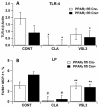Probiotic bacteria produce conjugated linoleic acid locally in the gut that targets macrophage PPAR γ to suppress colitis
- PMID: 22363592
- PMCID: PMC3283634
- DOI: 10.1371/journal.pone.0031238
Probiotic bacteria produce conjugated linoleic acid locally in the gut that targets macrophage PPAR γ to suppress colitis
Erratum in
-
Correction: Probiotic Bacteria Produce Conjugated Linoleic Acid Locally in the Gut That Targets Macrophage PPAR γ to Suppress Colitis.PLoS One. 2022 Sep 27;17(9):e0275513. doi: 10.1371/journal.pone.0275513. eCollection 2022. PLoS One. 2022. PMID: 36166465 Free PMC article.
Abstract
Background: Inflammatory bowel disease (IBD) therapies are modestly successful and associated with significant side effects. Thus, the investigation of novel approaches to prevent colitis is important. Probiotic bacteria can produce immunoregulatory metabolites in vitro such as conjugated linoleic acid (CLA), a polyunsaturated fatty acid with potent anti-inflammatory effects. This study aimed to investigate the cellular and molecular mechanisms underlying the anti-inflammatory efficacy of probiotic bacteria using a mouse model of colitis.
Methodology/principal findings: The immune modulatory mechanisms of VSL#3 probiotic bacteria and CLA were investigated in a mouse model of DSS colitis. Colonic specimens were collected for histopathology, gene expression and flow cytometry analyses. Immune cell subsets in the mesenteric lymph nodes (MLN), spleen, blood and colonic lamina propria cells were phenotypically and functionally characterized. Fecal samples and colonic contents were collected to determine the effect of VSL#3 and CLA on gut microbial diversity and CLA production. CLA and VSL#3 treatment ameliorated colitis and decreased colonic bacterial diversity, a finding that correlated with decreased gut pathology. Colonic CLA concentrations were increased in response to probiotic bacterial treatment, but without systemic distribution in blood. VSL#3 and CLA decreased macrophage accumulation in the MLN of mice with DSS colitis. The loss of PPAR γ in myeloid cells abrogated the protective effect of probiotic bacteria and CLA in mice with DSS colitis.
Conclusions/significance: Probiotic bacteria modulate gut microbial diversity and favor local production of CLA in the colon that targets myeloid cell PPAR γ to suppress colitis.
Conflict of interest statement
Figures







References
-
- Papadakis KA, Targan SR. Role of cytokines in the pathogenesis of inflammatory bowel disease. Annu Rev Med. 2000;51:289–298. - PubMed
-
- Bassaganya-Riera J, Reynolds K, Martino-Catt S, Cui Y, Hennighausen L, et al. Activation of PPAR gamma and delta by conjugated linoleic acid mediates protection from experimental inflammatory bowel disease. Gastroenterology. 2004;127:777–791. - PubMed
-
- Bassaganya-Riera J, Hontecillas R, Beitz DC. Colonic anti-inflammatory mechanisms of conjugated linoleic acid. Clin Nutr. 2002;21:451–459. - PubMed
-
- Serini S, Piccioni E, Merendino N, Calviello G. Dietary polyunsaturated fatty acids as inducers of apoptosis: implications for cancer. Apoptosis. 2009;14:135–152. - PubMed
MeSH terms
Substances
LinkOut - more resources
Full Text Sources
Other Literature Sources
Molecular Biology Databases

